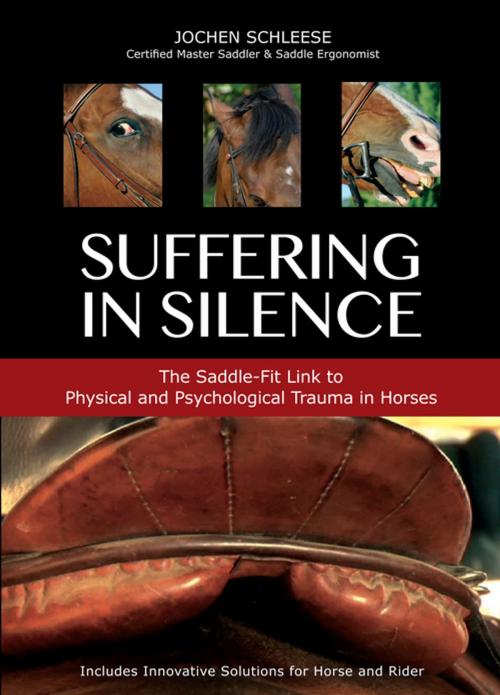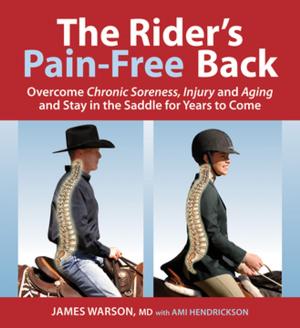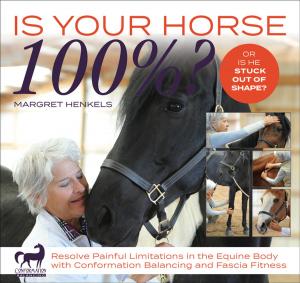Suffering in Silence
Exploring the Painful Truth: The Saddle-Fit Link to Physical and Psychological Trauma in Horses
Nonfiction, Sports, Horse Sports, Equestrian, Science & Nature, Pets, Horses, Nature| Author: | Jochen Schleese | ISBN: | 9781570767289 |
| Publisher: | Trafalgar Square Books | Publication: | September 15, 2014 |
| Imprint: | Trafalgar Square Books | Language: | English |
| Author: | Jochen Schleese |
| ISBN: | 9781570767289 |
| Publisher: | Trafalgar Square Books |
| Publication: | September 15, 2014 |
| Imprint: | Trafalgar Square Books |
| Language: | English |
Humans and horses have been joined for thousands of years, and for much of that time, one thing has served as the primary point of physical contact between them: the saddle.
However, for many horses and many riders, the saddle has been no less than a refined means of torture. Horses have long suffered from tree points impeding the movement of their shoulder blades; too narrow gullet channels damaging the muscles and nerves along the vertebrae; and too long panels putting harmful pressure on the reflex point in the loin area. Male riders saddle up despite riding-related pain and the potential for serious side effects, such as impotence, while female riders endure backache, slipped discs, and bladder infections, to name just a few common issues.
We must ask ourselves: How much better could we ride and how much better could our horses perform if our saddles fit optimally? If they accommodated the horse’s unique conformation and natural asymmetry? If they were built for the differing anatomy of men and women?
The answers to all these questions are right here, right now, in this book.
However, for many horses and many riders, the saddle has been no less than a refined means of torture. Horses have long suffered from tree points impeding the movement of their shoulder blades; too narrow gullet channels damaging the muscles and nerves along the vertebrae; and too long panels putting harmful pressure on the reflex point in the loin area. Male riders saddle up despite riding-related pain and the potential for serious side effects, such as impotence, while female riders endure backache, slipped discs, and bladder infections, to name just a few common issues.
We must ask ourselves: How much better could we ride and how much better could our horses perform if our saddles fit optimally? If they accommodated the horse’s unique conformation and natural asymmetry? If they were built for the differing anatomy of men and women?
The answers to all these questions are right here, right now, in this book.
Humans and horses have been joined for thousands of years, and for much of that time, one thing has served as the primary point of physical contact between them: the saddle.
However, for many horses and many riders, the saddle has been no less than a refined means of torture. Horses have long suffered from tree points impeding the movement of their shoulder blades; too narrow gullet channels damaging the muscles and nerves along the vertebrae; and too long panels putting harmful pressure on the reflex point in the loin area. Male riders saddle up despite riding-related pain and the potential for serious side effects, such as impotence, while female riders endure backache, slipped discs, and bladder infections, to name just a few common issues.
We must ask ourselves: How much better could we ride and how much better could our horses perform if our saddles fit optimally? If they accommodated the horse’s unique conformation and natural asymmetry? If they were built for the differing anatomy of men and women?
The answers to all these questions are right here, right now, in this book.
However, for many horses and many riders, the saddle has been no less than a refined means of torture. Horses have long suffered from tree points impeding the movement of their shoulder blades; too narrow gullet channels damaging the muscles and nerves along the vertebrae; and too long panels putting harmful pressure on the reflex point in the loin area. Male riders saddle up despite riding-related pain and the potential for serious side effects, such as impotence, while female riders endure backache, slipped discs, and bladder infections, to name just a few common issues.
We must ask ourselves: How much better could we ride and how much better could our horses perform if our saddles fit optimally? If they accommodated the horse’s unique conformation and natural asymmetry? If they were built for the differing anatomy of men and women?
The answers to all these questions are right here, right now, in this book.















